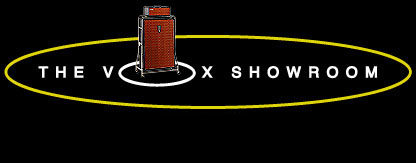

 JMI Vox AC-30SRT "Super Reverb Twin" Trapezoid Amp Head....1965 - 1966
JMI Vox AC-30SRT "Super Reverb Twin" Trapezoid Amp Head....1965 - 1966
|
|
2_Footer
|
© 1996 - 2024 The Vox Showroom, all rights reserved. No use on online auctions, eBay or Reverb.
|
 |
The Vox AC-30SRT amp head is considered by many to be the ultimate AC-30 amplifier. In his |
1992 book, "The Vox Story," former Vox lead engineer Dick Denney reported that this version of the AC-30 had the reputation of having the best sound of any Vox amplifier.
The three channel trapezoid amp head was offered in two versions, the "Super Twin" and "Super Reverb Twin."
The AC-30/6 Super Twin and AC-30/6 Super Reverb Twin both
|
| both featured "Top Boost circuitry," or independent treble and bass controls in the "Brilliant" channel. The Top Boost circuit had been originally offered by Vox as an optional dealer installed "add-on" kit. This aftermarket installation required that the treble and bass controls be mounted into a rectangular hole that was cut into the rear panel of the amplifier. By 1964, the popularity of the Top Boost circuit led Vox to offer the installation of Top Boost circuitry at the factory. The factory Top Boost installation moved the treble and bass controls from the back panel to the main control panel. The AC-30SRT amp head shown on this web page benefited from this factory installed, control panel mounted Top Boost circuit.
The "Cut" control was installed on the control panel alongside the treble and bass controls. This control rolled off the treble response on all three channels and was not part of the Top Boost circuitry.
|
|
By 1964, Vox recognized that reverb was becoming popular as an onboard effect in a number of Fender amplifiers. As a result, Tom Jennings, the director of JMI Vox, investigated the possibility of adding a Hammond reverb circuit to Vox amps. Hammond charged a one dollar per amp licensing fee to manufacturers that incorporated their patented reverb circuits. This ongoing license fee so infuriated Jennings that he led Vox to develop their own proprietary reverb circuit that included the infamous Vox crystal phono cartridge reverb pan. This circuit just barely skirted the design patents on the Hammond design.
The Vox reverb pan used a single delay spring stretched between the needle saddles of two ACOS GR71 crystal phono cartridges. These cartridges were used as the reverb drive and receive transducers. For those currently wishing to make repairs to this reverb pan, ACOS GR71 replacements are no longer available.
About all one could say about the JMI reverb pan is it worked to a degree, but the tone and depth of the reverb was certainly lacking when measured against comparable Fender amps. Furthermore, this phono cartridge based reverb pan would easily slip into a howling acoustic feedback if the amp was played too loudly. This tendency towards feedback forced Vox to restrict the installation of their reverb circuit to amp heads. Locating the reverb pan in the amp head distanced the microphonic phono cartridges from the speakers and minimized feedback.
As there was no more room in the AC-30 control panel, the reverb controls for the AC30SRT "Super Reverb Twin" amp head were installed in a rectangular cutout in the rear panel, exactly as done in the past with the "Top Boost" controls.
|
 .......Vox Crystal Phono Cartridge Reverb Pan
.......Vox Crystal Phono Cartridge Reverb Pan
|
The AC-30/6 Super Twin and Super Reverb Twin amps also featured the Vox "Vib/Trem" circuit. This effect was assigned to Vibrato channel in the amp and offered tremolo (amplitude modulation at varying speeds), vibrato (frequency modulation at varying speeds) or a combination of both.
The Vibrato channel had much lower gain and was not as clean as the Normal or Brilliant channels. As a result, the Vibrato channel was not all that popular with musicians. The input jacks for the Vibrato channel had white nuts for easy identification. In addition to two control panel mounted controls, a Vox "egg" foot switch remotely activated the effect.
|

Vox Head Cabinets by Thomas Organ were modeled after the JMI Super Twin..
|
The JMI (UK) AC30 Super Twin and Super Reverb Twin were the first Vox amp heads to utilize a trapezoid head cabinet. The design of the Jennings trapezoid Super Twin head cabinet was not only attractive and modern, it was amazingly compact and light weight. The cabinet was designed to be no larger than necessary to enclose an AC-30/6 chassis and reverb pan without wasted space.
Thomas Organ obviously was impressed with the design of the JMI Vox AC-30/6 Super Twin amp head. They closely modeled their Super Beatle, Royal Guardsman, Buckingham, Westminster and Sovereign amp head cabinets after the trapezoid AC-30/6 Super Twin.
|
 North Coast Music offers a large selection of replacement parts for the AC-30/6 amplifier.
Many of these items are manufactured exclusively by North Coast Music under license to Vox.
North Coast Music offers a large selection of replacement parts for the AC-30/6 amplifier.
Many of these items are manufactured exclusively by North Coast Music under license to Vox.
|
|
3_Footer

Photos and editorial content courtesy Gary Hahlbeck, North Coast Music
Any and all material presented herein is protected by Copyright.
© 1998 - 2024 The Vox Showroom and North Coast Music, all rights reserved
The images and editorial content in this web site may not be copied or reproduced
in online auction sites such as eBay, Reverb and Craig's List. Sellers may provide a link
to the Vox Showroom web site if they wish to refer to this copyrighted material.
|
URL: http://www.voxshowroom.com/uk/amp/ac30srt_head.html
|





